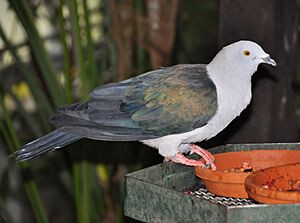Elegant imperial pigeon facts for kids
The elegant imperial pigeon (also called the blue-tailed imperial-pigeon) is a big, beautiful bird. It's a type of pigeon. Its top feathers are a shiny dark blue-green. Its head, neck, and belly are light grey. It has reddish-brown feathers under its tail.
Quick facts for kids Elegant imperial pigeon |
|
|---|---|
 |
|
| Conservation status | |
| Scientific classification | |
| Genus: |
Ducula
|
| Species: |
concinna
|
Contents
About the Elegant Imperial Pigeon
Scientists gave the elegant imperial pigeon its official name, Ducula concinna. A famous scientist named Alfred Russel Wallace first described this bird in 1865. He found it on the Watubela Islands.
What Does It Look Like?
The elegant imperial pigeon is a large bird, about 43 centimeters (17 inches) long.
- Head and Neck: Its head, neck, and upper back are light grey. The back of its neck and top of its head might have a pinkish tint.
- Body Feathers: The rest of its upper body is a shimmering dark green.
- Tail: The top of its tail is purplish-blue, sometimes looking black. The feathers under its tail are reddish-brown.
- Underparts: Its belly and chest are light grey, also with a pinkish tint.
- Wings: The undersides of its wings are black.
- Beak and Eyes: Its beak is black or bluish-grey. It has a ring of white feathers at the base of its beak. Its eyes are golden.
- Feet: Its feet are pinkish-red to deep red.
- Differences: Both male and female pigeons look similar. However, females usually have darker grey and pink colors. Young pigeons are not as brightly colored as adults.
What Sounds Does It Make?
The elegant imperial pigeon has a loud, deep call. It sounds like a barking urrauw. It makes this sound at different times. Sometimes, it also makes low, loud growls. These growls often happen after another pigeon has barked.
Where Does It Live?
The elegant imperial pigeon lives on small islands. These islands are found in a region called Wallacea and near New Guinea. You can find them in places like the Talaud Islands and the Maluku Islands. They also live in the eastern Lesser Sunda Islands and the Aru Islands. Sometimes, a few birds might fly to places like Buru or even Darwin, Australia.
This pigeon likes to live in different types of forests. It can be found in old, untouched forests or in forests that are growing back. It also likes the edges of forests and trees in farm areas. They mostly live in lowlands. But sometimes, you can find them in higher places, up to 850 meters (2,790 feet) high.
How Does It Live?
Scientists think these pigeons might fly between small islands. They do this to find food. One pigeon that flew all the way to Australia might have traveled with other pigeons.
What Does It Eat?
The elegant imperial pigeon loves to eat fruit! It has been seen eating young coconuts and figs. It also eats fruits from trees like Canarium species and Moluccan albizia. Sometimes, it eats fruits from fish poison trees and Indonesian mahogany. A pigeon seen in Australia was eating fruit from banyan and palm trees. Sometimes, you can see groups of up to 40 pigeons feeding together.
How Does It Raise Its Young?
On Damar, people saw these pigeons building nests in August. Two nests were found high up in evergreen forests. They were about 25 to 30 meters (82 to 98 feet) off the ground.

